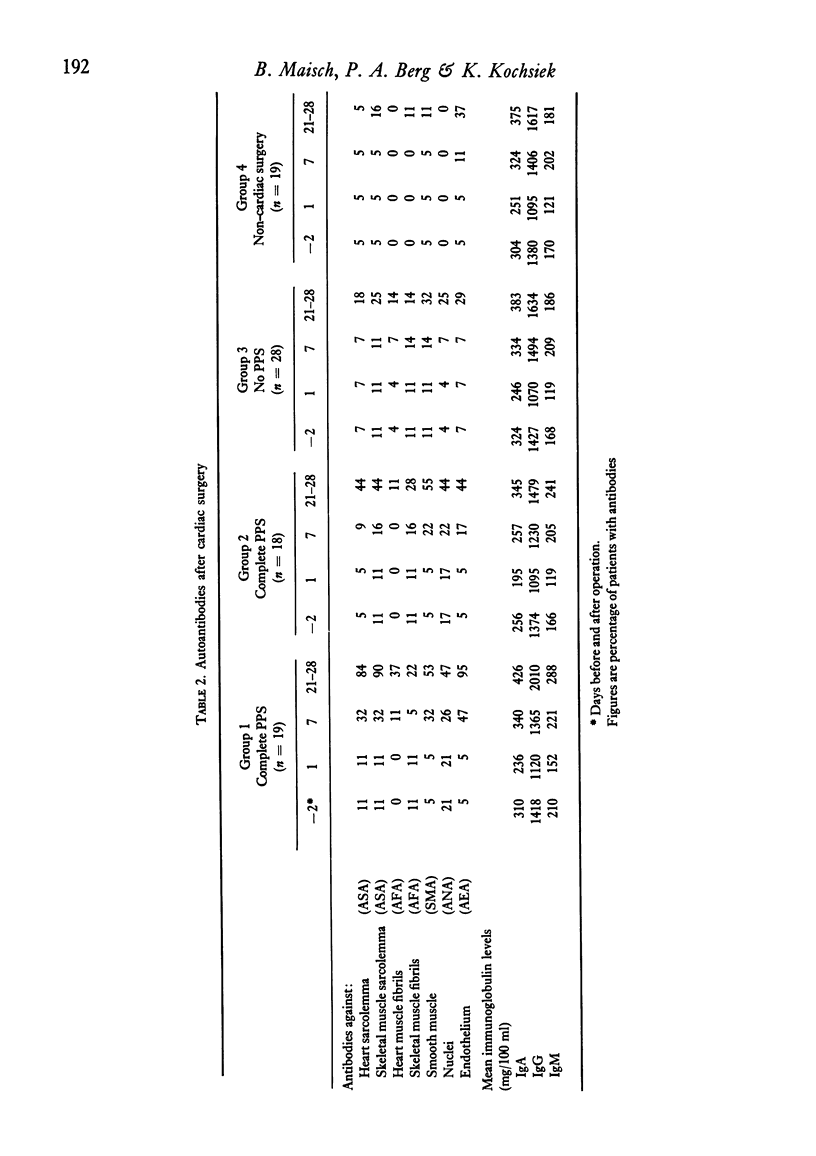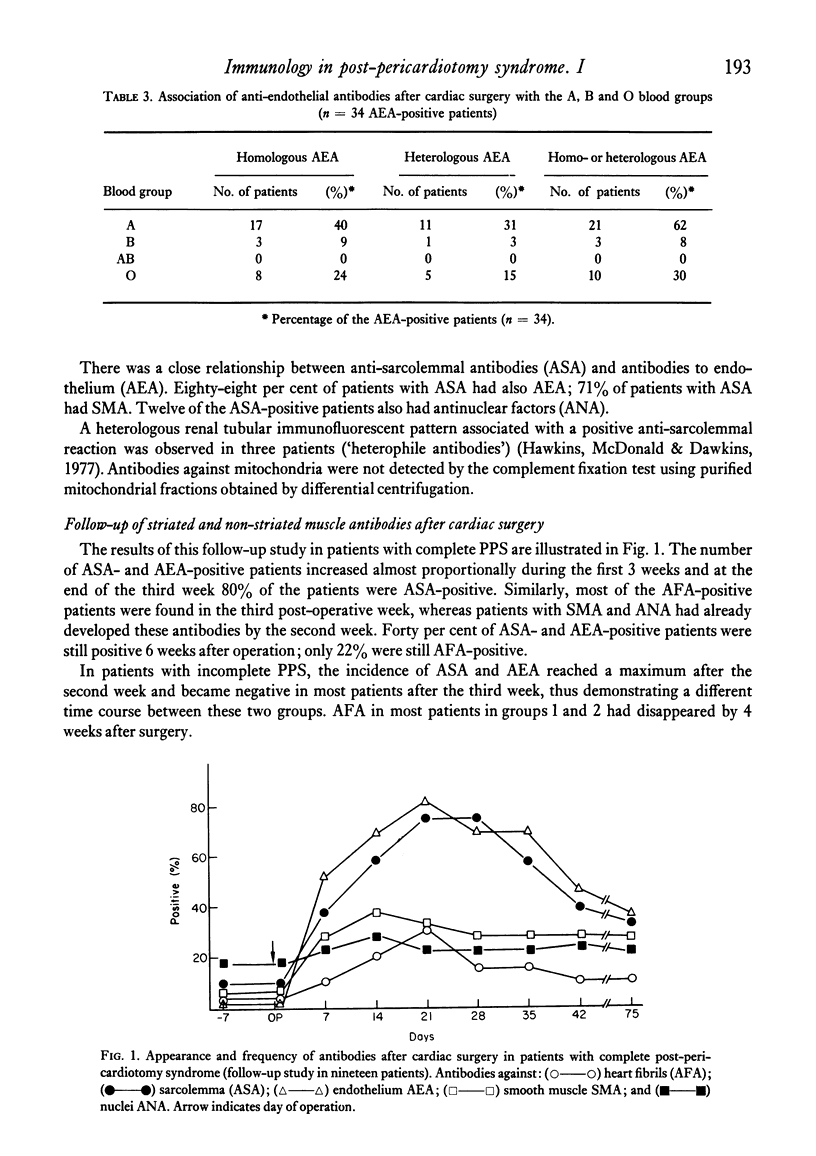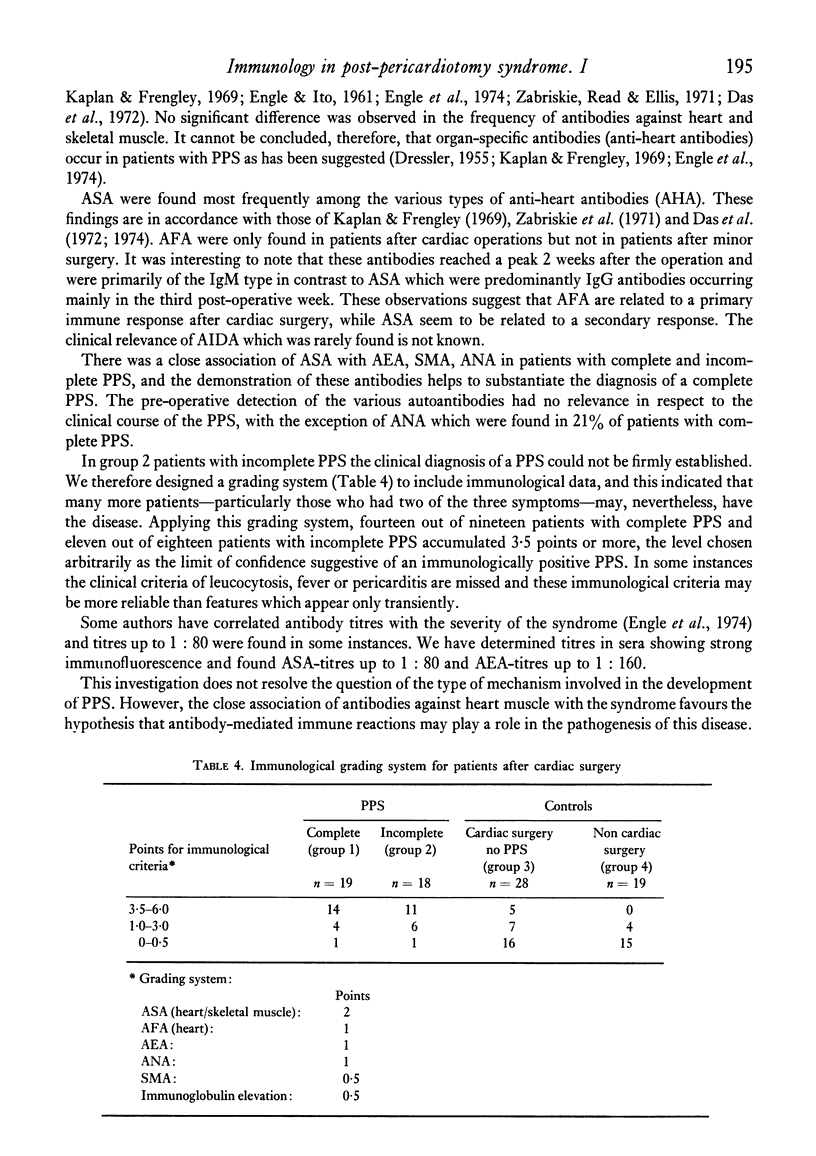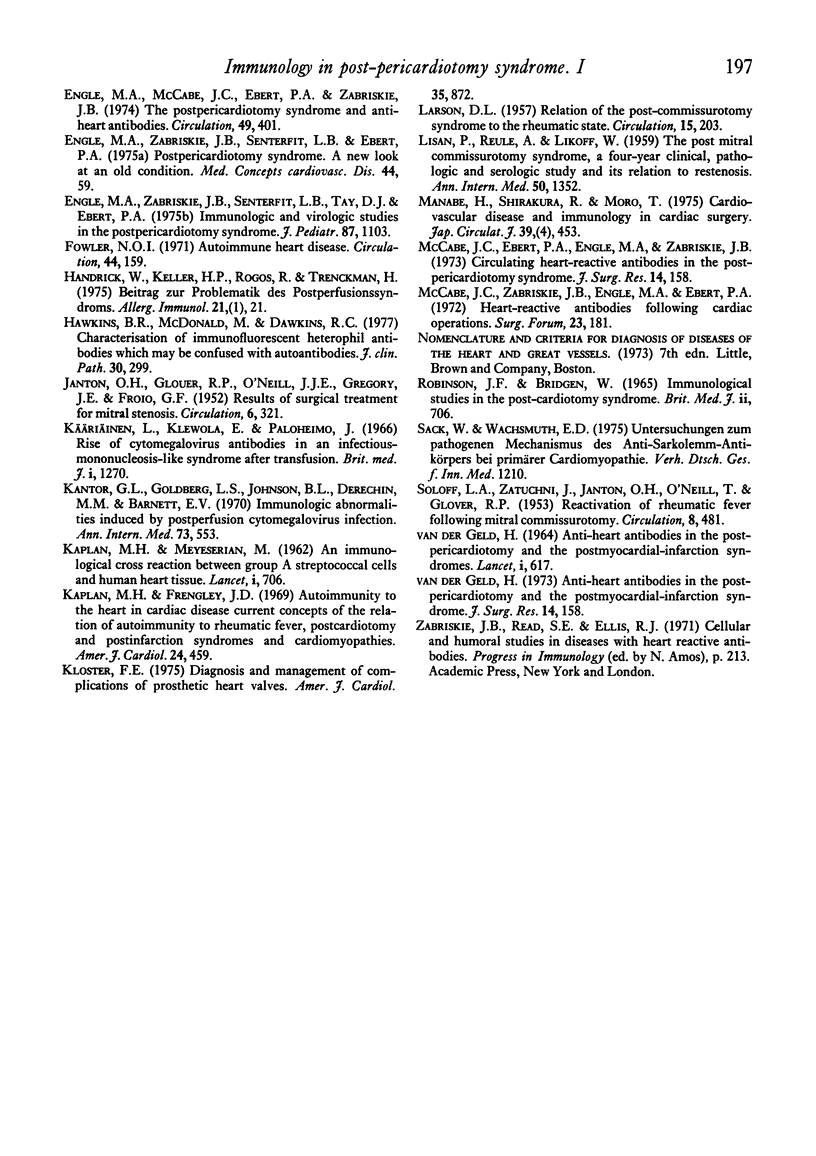Abstract
Sera from sixty-five patients were collected before and after cardiac surgery to determine striated muscle antibodies (anti-heart and anti-skeletal), non-organ-specific antibodies, immunoglobulin and complement levels. According to the clinical features of pericarditis, fever and leucocytosis, patients were divided into three groups: (1) complete post-pericardotomy syndrome (PPS) (n = 19) with all three symptoms; (2) incomplete PPS with two symptoms (n = 18); and (3) no PPS with one or no symtpoms (n = 28). Almost all the patients with complete PPS, two thirds of the patients with incomplete PPS and one third of the patients with no PPS showed striated muscle antibodies. Anti-sarcolemmal antibodies predominated.
In patients with complete PPS, antibodies persisted beyond the fourth post-operative week and correlated well with symptoms. An even better correlation with the syndrome could be obtained by including the post-operative occurrence of anti-endothelial (AEA), smooth muscle (SMA), the pre- and post-operative frequency of antinuclear antibodies (ANA) and the increase in immunoglobulin concentrations after surgery in an immunological grading system. These criteria permitted a redistribution of the nineteen patients with an incomplete PPS: fourteen were immunologically positive for a PPS. Although autoantibodies are predominantly associated with PPS, their role in the pathogenesis of the syndrome is not clear. The complementary influence of surgical and non-surgical factors, such as the degree of myocardial damage, the time of ischemia during the operation and a possible viral infection by blood transfusion, is analysed.
Full text
PDF








Selected References
These references are in PubMed. This may not be the complete list of references from this article.
- BAER D. M., OSBORN J. J. The postperfusion pulmonary congestion syndrome. Am J Clin Pathol. 1960 Nov;34:442–445. doi: 10.1093/ajcp/34.5.442. [DOI] [PubMed] [Google Scholar]
- BERGSTROM I., DAHLSTROM G. Fever with a blood picture resembling infectious mononucleosis in operated tuberculous cases. Acta Tuberc Scand. 1957;34(1-2):132–139. [PubMed] [Google Scholar]
- Berg P. A., Binder T., Lindner H., Bannaski H., Maas D., Henning H., Brügel H. Heterogenität mitochondrialer Autoantikörper. Zur serologischen Diagnose der primär-biliären Zirrhose und des Pseudo-Lupus erythematodes mit Hilfe von zwei verschiedenen Antigenfraktionen. Dtsch Med Wochenschr. 1975 May 16;100(20):1123–1127. doi: 10.1055/s-0028-1106345. [DOI] [PubMed] [Google Scholar]
- Berg P. A., Doniach D., Roitt I. M. Mitochondrial antibodies in primary biliary cirrhosis. I. Localization of the antigen to mitochondrial membranes. J Exp Med. 1967 Aug 1;126(2):277–290. doi: 10.1084/jem.126.2.277. [DOI] [PMC free article] [PubMed] [Google Scholar]
- Berg P. A. Humorale Immunphänomene bei akuter und chronishcer Virushepatitis. Immun Infekt. 1975 Aug;3(4):172–181. [PubMed] [Google Scholar]
- Berg P. A., Roitt I. M., Doniach D., Horne R. W. Mitochondrial antibodies in primary biliary cirrhosis. 3. Characterization of the inner-membrane complement fixing antigen. Clin Exp Immunol. 1969 May;4(5):511–525. [PMC free article] [PubMed] [Google Scholar]
- COONS A. H., KAPLAN M. H. Localization of antigen in tissue cells; improvements in a method for the detection of antigen by means of fluorescent antibody. J Exp Med. 1950 Jan 1;91(1):1–13. doi: 10.1084/jem.91.1.1. [DOI] [PMC free article] [PubMed] [Google Scholar]
- DAVIES A. M., GERY I. The role of autoantibodies in heart disease. Am Heart J. 1960 Nov;60:669–674. doi: 10.1016/0002-8703(60)90350-1. [DOI] [PubMed] [Google Scholar]
- DRESDALE D. T., RIPSTEIN C. B., GUZMAN S. V., GREENE M. A. Postcardiotomy syndrome in patients with rheumatic heart disease; cortisone as a prophylactic and therapeutic agent. Am J Med. 1956 Jul;21(1):57–74. doi: 10.1016/0002-9343(56)90008-0. [DOI] [PubMed] [Google Scholar]
- DRESSLER W. Idiopathic recurrent pericarditis; comparison with the postcommissurotomy syndrome; considerations of etiology and treatment. Am J Med. 1955 Apr;18(4):591–601. doi: 10.1016/0002-9343(55)90459-9. [DOI] [PubMed] [Google Scholar]
- DRUSIN L. M., ENGLE M. A., HAGSTROM J. W., SCHWARTZ M. S. THE POSTPERICARDIOTOMY SYNDROME: A SIX-YEAR EPIDEMIOLOGIC STUDY. N Engl J Med. 1965 Mar 25;272:597–602. doi: 10.1056/NEJM196503252721201. [DOI] [PubMed] [Google Scholar]
- Das S. K., Cassidy J. T., Petty R. E. Antibodies against heart muscle and nuclear constituents in cardiomyopathy. Am Heart J. 1972 Feb;83(2):159–166. doi: 10.1016/0002-8703(72)90134-2. [DOI] [PubMed] [Google Scholar]
- Das S. K., Cassidy J. T., Petty R. E. The significance of heart-reactive antibodies in heart disease. Chest. 1974 Aug;66(2):179–181. doi: 10.1378/chest.66.2.179. [DOI] [PubMed] [Google Scholar]
- ENGLE M. A., ITO T. The postpericardiotomy syndrome. Am J Cardiol. 1961 Jan;7:73–82. doi: 10.1016/0002-9149(61)90425-8. [DOI] [PubMed] [Google Scholar]
- Engle M. A., McCabe J. C., Ebert P. A., Zabriskie J. The Postpericardiotomy syndrome and antiheart antibodies. Circulation. 1974 Mar;49(3):401–406. doi: 10.1161/01.cir.49.3.401. [DOI] [PubMed] [Google Scholar]
- Engle M. A., Zabriskie J. B., Senterfit L. B., Ebert P. A. Postpericardiotomy syndrome. A new look at an old condition. Mod Concepts Cardiovasc Dis. 1975 Nov;44(11):59–64. [PubMed] [Google Scholar]
- Engle M. A., Zabriskie J. B., Senterfit L. B., Tay D. J., Ebert P. A. Immunologic and virologic studies in the postpericardiotomy syndrome. J Pediatr. 1975 Dec;87(6 Pt 2):1103–1108. doi: 10.1016/s0022-3476(75)80122-3. [DOI] [PubMed] [Google Scholar]
- Fowler N. O. Autoimmune heart disease. Circulation. 1971 Aug;44(2):159–162. doi: 10.1161/01.cir.44.2.159. [DOI] [PubMed] [Google Scholar]
- Hawkins B. R., McDonald B. L., Dawkins R. L. Characterisation of immunofluorescent heterophile antibodies which may be confused with autoantibodies. J Clin Pathol. 1977 Apr;30(4):299–307. doi: 10.1136/jcp.30.4.299. [DOI] [PMC free article] [PubMed] [Google Scholar]
- JANTON O. H., GLOVER R. P., O'NEILL T. J. E., GREGORY J. E., FROIO G. F. Results of the surgical treatment for mitral stenosis; analysis of one hundred consecutive cases. Circulation. 1952 Sep;6(3):321–333. doi: 10.1161/01.cir.6.3.321. [DOI] [PubMed] [Google Scholar]
- KAPLAN M. H., MEYESERIAN M. An immunological cross-reaction between group-A streptococcal cells and human heart tissue. Lancet. 1962 Apr 7;1(7232):706–710. doi: 10.1016/s0140-6736(62)91653-7. [DOI] [PubMed] [Google Scholar]
- Kantor G. L., Goldberg L. S., Johnson B. L., Jr, Derechin M. M., Barnett E. V. Immunologic abnormalities induced by postperfusion cytomegalovirus infection. Ann Intern Med. 1970 Oct;73(4):553–558. doi: 10.7326/0003-4819-73-4-553. [DOI] [PubMed] [Google Scholar]
- Kaplan M. H., Frengley J. D. Autoimmunity to the heart in cardiac disease. Current concepts of the relation of autoimmunity to rheumatic fever, postcardiotomyand postinfarction syndromes and cardiomyopathies. Am J Cardiol. 1969 Oct;24(4):459–473. doi: 10.1016/0002-9149(69)90489-5. [DOI] [PubMed] [Google Scholar]
- Kloster F. E. Diagnosis and management of complications of prosthetic heart valves. Am J Cardiol. 1975 Jun;35(6):872–885. doi: 10.1016/0002-9149(75)90124-1. [DOI] [PubMed] [Google Scholar]
- Käriäinen L., Klemola E., Paloheimo J. Rise of cytomegalovirus antibodies in an infectious-mononucleosis-like syndrome after transfusion. Br Med J. 1966 May 21;1(5498):1270–1272. doi: 10.1136/bmj.1.5498.1270. [DOI] [PMC free article] [PubMed] [Google Scholar]
- LARSON D. L. Relation of the postcommissurotomy syndrome to the rheumatic state. Circulation. 1957 Feb;15(2):203–209. doi: 10.1161/01.cir.15.2.203. [DOI] [PubMed] [Google Scholar]
- LISAN P., REALE A., LIKOFF W. The postmitral commissurotomy syndrome: a four-year clinical, pathologic and serologic study, and its relation to restenosis. Ann Intern Med. 1959 Jun;50(6):1352–1358. doi: 10.7326/0003-4819-50-6-1352. [DOI] [PubMed] [Google Scholar]
- Manabe H., Shirakura R., Mori T. Cardiovascular disease and immunology in cardiac surgery. Jpn Circ J. 1975 Apr;39(4):453–458. doi: 10.1253/jcj.39.453. [DOI] [PubMed] [Google Scholar]
- McCabe J. C., Ebert P. A., Engle M. A., Zabriskie J. B. Circulating heart-reactive antibodies in the postpericardiotomy syndrome. J Surg Res. 1973 Feb;14(2):158–164. doi: 10.1016/0022-4804(73)90025-5. [DOI] [PubMed] [Google Scholar]
- McCabe J. C., Zabriskie J. B., Engle M. A., Ebert P. A. Heart-reactive antibodies following cardiac operations. Surg Forum. 1972;23(0):181–182. [PubMed] [Google Scholar]
- SOLOFF L. A., ZATUCHNI J., JANTON O. H., O'NEILL T. J., GLOVER R. P. Reactivation of rheumatic fever following mitral commissurotomy. Circulation. 1953 Oct;8(4):481–497. doi: 10.1161/01.cir.8.4.481. [DOI] [PubMed] [Google Scholar]
- VAN DER GELD H. ANTI-HEART ANTIBODIES IN THE POSTPERICARDIOTOMY AND THE POSTMYOCARDIAL-INFARCTION SYNDROMES. Lancet. 1964 Sep 19;2(7360):617–621. doi: 10.1016/s0140-6736(64)90512-4. [DOI] [PubMed] [Google Scholar]


